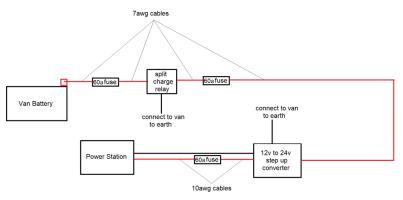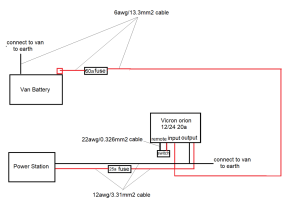holly_brown96
Member
Hi, just looking for a bit of advice. I have a portable power station battery. I have 3 100w solar panels but in winter, it's not producing the power I need so I want to fit a voltage sensitive split charge relay to my van to power the van as I drive. The best way to do this I have found is to install a 12v to 24v step up converter along with the split charge relay as it needs to trick my power station into thinking 24v solar panels have been attached otherwise it will only delivery 12v to my solar input and less wattage. My power station is 2000w and accepts 500w, 11.5-50v and 20a through the solar input. My van battery will be changed soon to a 70ah and my alternator is 140a. Would this system work:
This split charge relay kit which uses 7awg cables, 60a fuses and split charge relay is 140a: https://www.amazon.co.uk/gp/product/B0D17CL4RS/?tag=mhf04-21
This is the 12v to 24v step up converter: https://www.amazon.co.uk/gp/product/B09F3J45FW/?tag=mhf04-21
After the 12v to 24v converter, add one of these 60a fuses to the cable: https://www.amazon.co.uk/gp/product/B0BSGC8CKC/?tag=mhf04-21
And then this 10awg cable to go from the fuse holder after the 12v to 24v converter to then plug into my battery: https://www.amazon.co.uk/gp/product/B0CZ68Z8GG/?tag=mhf04-21
Would that all work or should I change some things? I have attached a photo of the system. Thanks

This split charge relay kit which uses 7awg cables, 60a fuses and split charge relay is 140a: https://www.amazon.co.uk/gp/product/B0D17CL4RS/?tag=mhf04-21
This is the 12v to 24v step up converter: https://www.amazon.co.uk/gp/product/B09F3J45FW/?tag=mhf04-21
After the 12v to 24v converter, add one of these 60a fuses to the cable: https://www.amazon.co.uk/gp/product/B0BSGC8CKC/?tag=mhf04-21
And then this 10awg cable to go from the fuse holder after the 12v to 24v converter to then plug into my battery: https://www.amazon.co.uk/gp/product/B0CZ68Z8GG/?tag=mhf04-21
Would that all work or should I change some things? I have attached a photo of the system. Thanks




